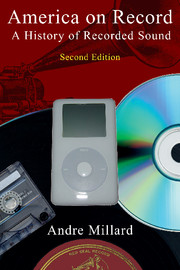Book contents
- Frontmatter
- Dedication
- Contents
- Preface to the second edition
- Preface to the first edition
- Introduction
- Part One The acoustic era
- 1 The inventors
- 2 A phonograph in every home
- 3 The international industry of recorded sound
- 4 The music
- 5 Recorded sound in the Jazz Age
- Part Two The electrical era
- Part Three The digital era
- Abbreviations used in the notes
- Notes
- Select discography
- Select bibliography
- Subject index
- Recordings index
- Motion picture index
2 - A phonograph in every home
from Part One - The acoustic era
Published online by Cambridge University Press: 05 February 2015
- Frontmatter
- Dedication
- Contents
- Preface to the second edition
- Preface to the first edition
- Introduction
- Part One The acoustic era
- 1 The inventors
- 2 A phonograph in every home
- 3 The international industry of recorded sound
- 4 The music
- 5 Recorded sound in the Jazz Age
- Part Two The electrical era
- Part Three The digital era
- Abbreviations used in the notes
- Notes
- Select discography
- Select bibliography
- Subject index
- Recordings index
- Motion picture index
Summary
Edison always said that the phonograph was his only real discovery, the only invention he stumbled upon rather than deliberately set out to find. Having invented it, he then had to find a use for it. Musical entertainment was one of the first uses he predicted for the phonograph, although it was by no means the only one. The inventors claimed that it would change education, politics, and business communication in addition to providing entertainment. Edison also thought it could be adapted for phonographic books for the blind, the teaching of elocution, and speaking clocks.
The phonograph was invented to save telephone messages, and the ability to record speech opened up several commercial uses. Chief among these was its employment as a dictating machine for businessmen. A talking machine could be used to replace the tedious exchange of letters with the recorded message of the phonograph cylinder. The inventors hoped that the cylinder could be sent through the mail with the ease of a letter. The advantage was that the recipient got an exact record of the sender's message as he dictated it, substituting a sound recording for correspondence. The paperless business office was anticipated well before the advent of personal computers and modems.
Edison hoped that this idea would transform office work. The electric light, telephone, and typewriter were slowly changing the American office, facilitating the task of managing the larger business organizations of the late nineteenth century. When used as a dictating machine, the phonograph promised to further ease the burden of business administration by mechanizing correspondence. The device that had begun as a complement to the telephone was now seen as an adjunct to the typewriter.
At the same time that Edison was imagining the phonograph as the ultimate business tool, he also made a prophetic statement about its future. “This machine,” he wrote in 1878, shortly after the clamor surrounding the invention had died down, “can only be built on the American principle of interchangeability of parts like a gun or a sewing machine.”
- Type
- Chapter
- Information
- America on RecordA History of Recorded Sound, pp. 37 - 64Publisher: Cambridge University PressPrint publication year: 2005



